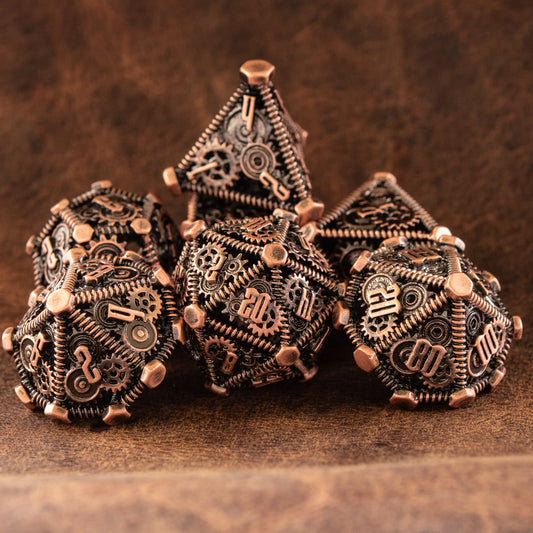D4 How to Bloodmark
Share
In Dungeons & Dragons (D&D) and other tabletop role-playing games, dice are not only tools of chance but also objects of creativity and personalization. One intriguing method of customizing dice is "bloodmarking." Bloodmarking involves adding a unique, often red-colored mark to certain numbers on the dice, creating a dramatic and thematic touch. For a die like the D4 (a four-sided die), bloodmarking is a method often used to signify critical rolls or aesthetic customizations that add a personal or symbolic touch to the gaming experience.
In this detailed guide, we will explore what bloodmarking is, how it applies to the D4 die, and provide a step-by-step guide on how to achieve professional-quality bloodmarks for your dice. Whether you're a dice maker or a player looking to add flair to your set, this guide will walk you through the process in detail.
What is Bloodmarking?
Bloodmarking refers to a dice-modification technique where one or more sides of a die are marked, typically using red pigment, to create the appearance of blood. This can be done to evoke a sense of danger or risk, such as highlighting critical hits, or simply as a way to enhance the aesthetics of a die.
In D&D, players often use the D4 die for determining damage from small weapons, spell effects, or class features. Bloodmarking specific sides of the D4 can create a thematic focus on danger or victory, depending on how it’s applied.
Why Bloodmark a D4?
The D4 is one of the more iconic dice used in D&D, due to its pyramid shape and role in determining minimal but critical damage in combat scenarios. Bloodmarking a D4 can be used to:
- Highlight Important Rolls: Marking a particular face (such as the number 4) with a bloodmark can serve as a visual cue for critical damage.
- Enhance Role-Playing Themes: For players with characters like rogues or assassins, bloodmarking can reinforce a narrative of lethality or danger in every roll.
- Aesthetic Customization: Bloodmarking simply adds a unique and creative touch, making your dice visually striking and personalized.
Tools and Materials Needed for Bloodmarking a D4
Before beginning the bloodmarking process, it’s essential to gather the right materials and tools to ensure the marks are durable, clear, and aesthetically pleasing.
Materials Required:
- A D4 Die: Start with a resin, plastic, or metal D4. Resin and plastic dice are easier to mark compared to metal dice.
- Red Ink or Paint: Acrylic paint or alcohol ink in shades of red will give you the blood-like effect. Alcohol inks are preferred for their durability and staining properties.
- Fine Detail Brush or Toothpick: A fine brush will help you paint precise, thin lines and small details. A toothpick works well for applying ink in controlled amounts.
- Varnish or Sealer: To protect the bloodmark and prevent it from fading, use a clear gloss or matte varnish.
- Masking Tape or Painter’s Tape: Use this to cover areas you don’t want to mark.
- Paper Towels: For cleaning up any excess paint or ink.
- Gloves and Safety Gear: If using alcohol inks, gloves are recommended to avoid staining your hands.
Optional:
- UV Resin: For dice-makers, adding a thin layer of UV resin over the bloodmark can enhance its appearance and protect the paint or ink from wear.
- Dice Tray or Box: To hold the die in place while marking and drying.
Step-by-Step Guide to Bloodmarking a D4
Step 1: Plan Your Bloodmark Design
Before you start applying ink or paint to the die, take some time to plan out where you want the bloodmarks to be. Most commonly, the bloodmark is applied to the highest number on the die (which is the 4 on a D4). This symbolizes critical success or damage. However, you can choose to mark other faces, such as lower numbers, if they hold symbolic importance in your campaign.
Decide whether you want a single face marked, multiple faces, or even blood-like streaks running across several faces.
Step 2: Prepare the D4 for Marking
Clean the surface of the D4 with a damp cloth or rubbing alcohol to remove any oils or dust that could interfere with the ink or paint adhesion.
If you’re concerned about precision, you can use masking tape to cover any areas of the D4 that you want to protect from accidental smudges. For example, you can mask off the faces you don’t want marked while leaving the target number exposed.
Step 3: Apply the Bloodmark
Using your fine detail brush or toothpick, dip it into the red ink or paint and carefully apply it to the chosen face(s) of the D4. If you want a realistic blood effect, focus on creating irregular, slightly streaky lines to mimic the way blood naturally flows.
For more dramatic effects, you can create small splatters or streaks extending from the face’s edges. Keep in mind that D4s have pointed corners, which can provide an opportunity for natural-looking “drips” in the design.
If you’re going for a more subtle mark, simply fill in the number on the die with a solid red pigment, highlighting the specific side without any additional details.
Tip: When working with alcohol inks, a little goes a long way. Start with small amounts and build up the intensity gradually.
Step 4: Let the Ink Dry
After applying the ink or paint, allow it to dry completely before handling the die. This can take anywhere from 15 minutes to a few hours depending on the material used. To avoid smudging, place the die on a soft surface like a dice tray or a small box where it can dry undisturbed.
Step 5: Add a Protective Seal
Once the ink or paint has fully dried, apply a layer of clear varnish or sealer over the bloodmarked area. This will protect the design from wear and tear during gameplay, ensuring it remains vibrant even after frequent use. If using a spray varnish, make sure to do this in a well-ventilated area.
For dice-makers who want a more durable finish, applying a thin coat of UV resin over the bloodmark can provide extra protection and give the design a glossy, glass-like sheen. Simply apply the resin over the bloodmark, cure it under a UV lamp, and you’re done.
Step 6: Inspect the Final Product
After the sealer or varnish has dried, carefully inspect your D4 to make sure the bloodmark is smooth, free of bubbles, and evenly applied. If there are any areas that need touching up, you can repeat the process of applying ink and sealing it again.
Advanced Techniques for Bloodmarking
Once you’ve mastered the basic bloodmarking technique, you can experiment with more advanced methods to create even more dynamic and striking designs.
1. Layered Bloodmarks
For a more textured and realistic effect, you can apply the bloodmark in multiple layers. Start with a dark red or black base layer, then gradually build up with lighter red tones on top to create depth and dimension.
2. Glow-in-the-Dark Bloodmarks
For an added twist, you can mix a small amount of glow-in-the-dark powder or pigment into the ink or paint you use for the bloodmark. This will give the dice an eerie, glowing effect during nighttime play or in dimly lit environments, adding an extra level of immersion to your D&D campaign.
3. Thematic Bloodmarks
Customize the bloodmark to match the theme of your character or campaign. For example, if your character is a fire mage, you might use orange or red-gold pigments to create a fiery, molten bloodmark. If your character is undead or vampiric, you could use darker, almost blackened bloodmarks to reflect their sinister nature.
Common Mistakes to Avoid
While bloodmarking is a fun and creative process, there are a few pitfalls to watch out for:
- Over-Saturating the Mark: Too much paint or ink can lead to blotchy results. Always start with a small amount and build up gradually.
- Impatience with Drying: Rushing the drying process can cause smudging or uneven marks. Be patient and let each layer dry thoroughly.
- Skipping the Sealing Process: Failing to apply a protective seal can lead to the bloodmark fading over time. Always protect your hard work with a varnish or resin seal.
Final Thoughts
Bloodmarking a D4 is an excellent way to customize your dice set, creating a dramatic and personalized element that enhances both the visual and thematic aspects of gameplay. By following this detailed guide, you can transform an ordinary D4 into a piece of art that reflects your character’s personality and story. Whether you're a dice maker or a D&D enthusiast, bloodmarking adds a unique, personal touch to your game, making every roll feel more significant and immersive.

